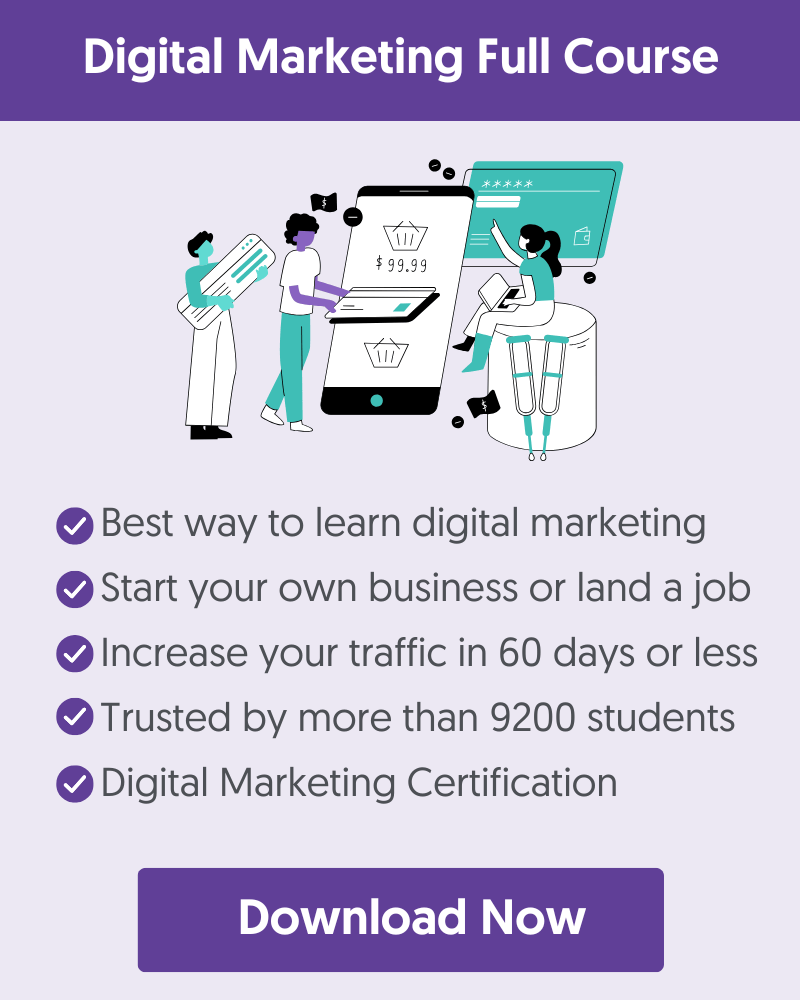Business-to-business (B2B) organizations sell products and services to other businesses. Like any company, they rely on marketing to reach customers and spread the word about their offerings.
In this beginner's guide for B2B digital marketing, you’ll learn what B2B marketing is, the difference between b2b and b2c marketing, and actionable b2b marketing strategies to use today for the best possible results.
What is B2B Digital Marketing?
B2B digital marketing refers to the strategies and tactics businesses use to promote their products or services to other businesses through online channels. Unlike B2C marketing, which targets individual consumers, B2B marketing focuses on reaching decision-makers within organizations.
A strong B2B digital marketing strategy builds brand awareness, educates potential clients, and nurtures relationships that lead to sales. This process often involves multiple touchpoints across channels like company websites, email campaigns, LinkedIn, content marketing, and paid advertising.
Because selling to businesses is more complex than selling to consumers, B2B marketing requires a strategic approach. Buyers typically go through a longer decision-making process involving multiple stakeholders and in-depth research before purchasing. An effective strategy ensures your business stays top of mind, delivers value, and converts prospects into loyal customers.
B2B Marketing VS B2C Marketing
Marketing to businesses is notably different from marketing to consumers, which is why B2B marketing exists. Here are some of the key differences:
| Tactic | B2B Marketing | B2C Marketing |
|---|---|---|
| Audience Targeting | Company Owners, Decision Makers | General Public |
| SEO | Low-volume, long-tail keywords | High volume, short tail keywords |
| PPC Marketing | High CPC keywords | Low and average CPC keywords |
| Content Marketing | In-depth, thought-leading content | More generic content |
| Social Media Marketing | Networking and knowledge sharing | Brand awareness and audience engagement |
| Affiliate Marketing | Setup a partner program and give commissions to other companies | Establish an affiliate program and find publishers and influencers to promote your goods. |
| YouTube Marketing | Short content targeting high-volume keywords | Long, info-packed videos targeting low-volume, informational keywords |
Let's see how each marketing tactic differs between B2B and B2C.
B2B targets decision-makers, and B2C targets individuals
The most significant difference between B2B and B2C marketing is audience targeting.
B2C marketing targets individual consumers. B2B, however, targets company decision-makers. These can be a single person per organization or a team.
So, while B2B still involves marketing to people, these parties are making decisions on the part of the organization, making the company the ultimate customer.
This means B2B buyers are more practical and less emotional in their decision-making, as any purchase needs to benefit the company.
B2B sales cycles are longer compared to B2C
B2B sales take longer to close. While consumers frequently buy things on impulse and without research, B2B buyers will take months to evaluate their needs and the solutions in the market before deciding what to purchase.
B2B marketing targets long-tail keywords, and B2C targets high-volume head keywords
Traffic from search engines is a big part of both B2C and B2B marketing. However, there are some big differences in the keywords targeted by these marketing strategies.
B2C marketing will focus on short keywords with high search volume.
Conversely, B2B marketing primarily focuses on long-tail keywords with lower search volume. This is because business buyers' searches are more specific than general consumer queries.
B2B paid advertising costs more than B2C
B2B sales have a much higher average value than sales to consumers. This makes sense, as companies have more money to spend and far greater needs.
Because B2B transactions generate more revenue, these companies are willing to pay more to advertise their business.
This leads to notably higher cost-per-clicks (CPC) for ads for B2B marketers.
B2B marketing is about creating In-depth, data-driven content
B2B and B2C marketing use content as part of their marketing strategies, but they do so differently.
B2C companies can create content strictly to sell or capture their audience's attention.
B2B marketers must provide thorough, data-driven, authoritative content to connect with their audience.
Providing value and proving expertise are more critical to earning a sale.
Professional social media networks are more suited for B2B marketing
Social media networks are important for B2C and B2B companies alike. The two, however, tend to focus on different platforms.
The platforms with the largest reach (Facebook, TikTok, and Instagram) are most effective for B2C marketing.
For B2B, a professional platform like LinkedIn is the most impactful. Twitter is also more suitable for businesses to connect with and sell to professionals and other companies.
Direct communication is still a great sales channel for B2B marketing
B2C marketing and sales is impersonal. Businesses don’t know the individuals buying their products, and there is limited to no direct communication between buyers and sellers.
However, with B2B, there is often direct communication between the seller and the buyer. Companies usually talk to and nurture leads for weeks before they become sales.
This typically takes place through email but can sometimes happen over the phone.
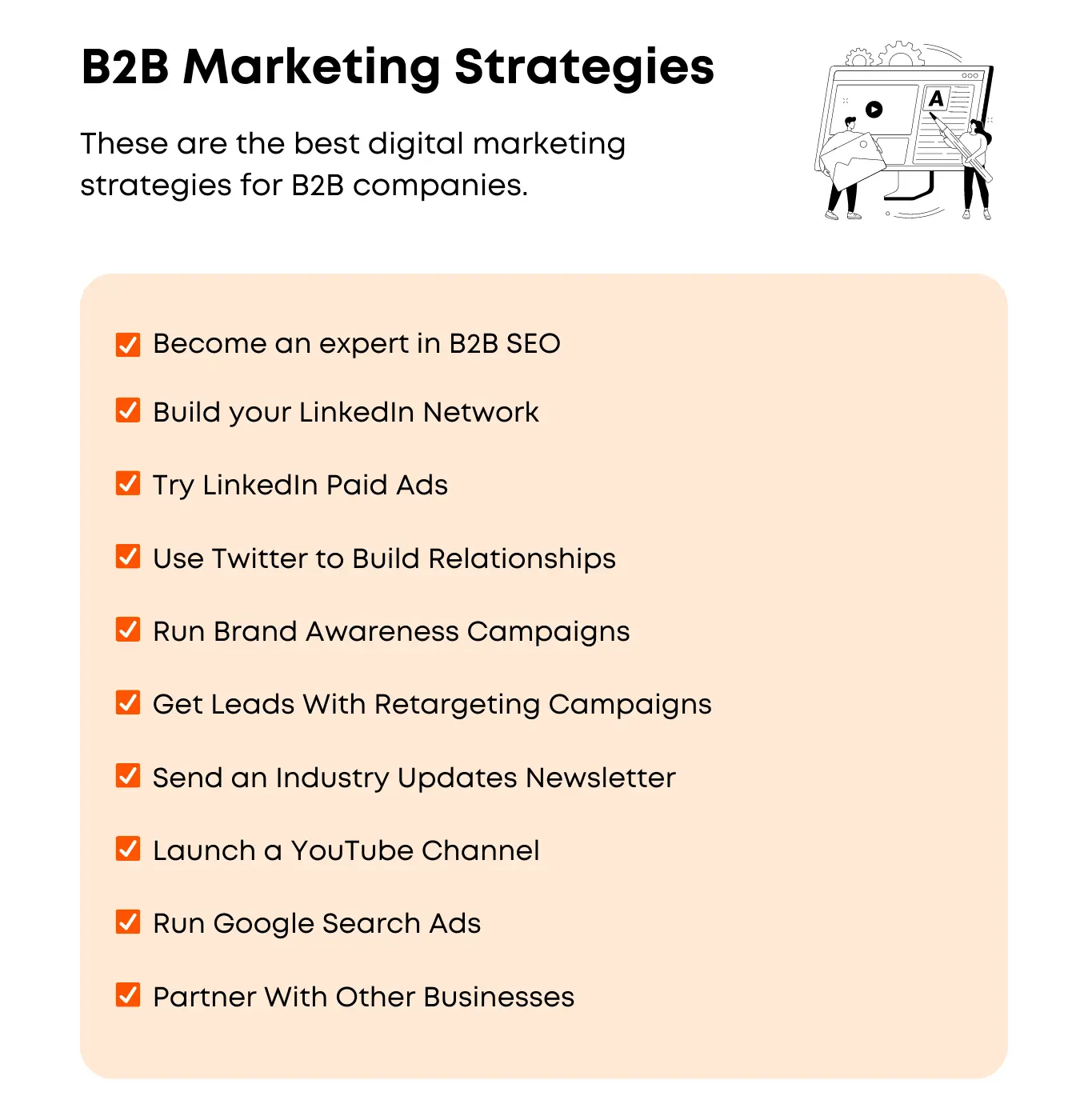
Best Digital Marketing Strategies For B2B Companies
- Become an expert in B2B SEO
- Build your LinkedIn Network
- Try LinkedIn Paid Ads
- Use Twitter to Build Relationships
- Run Brand Awareness Campaigns
- Get Leads With Retargeting Campaigns
- Send an Industry Updates Newsletter
- Launch a YouTube Channel
- Run Google Search Ads
- Partner With Other Businesses
1. Become an Expert in B2B SEO
Google research shows that 89% of B2B decision-makers use the internet to research and discover products. When these companies go online, many use a search engine like Google to conduct their research.
As such, search engines are one of the most important acquisition channels for many companies. This makes it critical for B2B organizations to get their website to the top of search rankings for the search terms used by their target customers.
Search engine optimization (SEO) is the marketing strategy used to improve rankings and drive more traffic searchers.
Finding keywords for B2B SEO
Implementing a successful B2B SEO strategy requires detailed keyword research. This is the process of finding the exact search terms that customers use. This knowledge lets you know what topics to create pages and content for.
For B2B marketers, it’s essential to find the keywords your audience uses at every stage of the digital marketing funnel. This includes the awareness phase, where prospects interact with you for the first time, and the conversion phase, where the prospect becomes a customer.
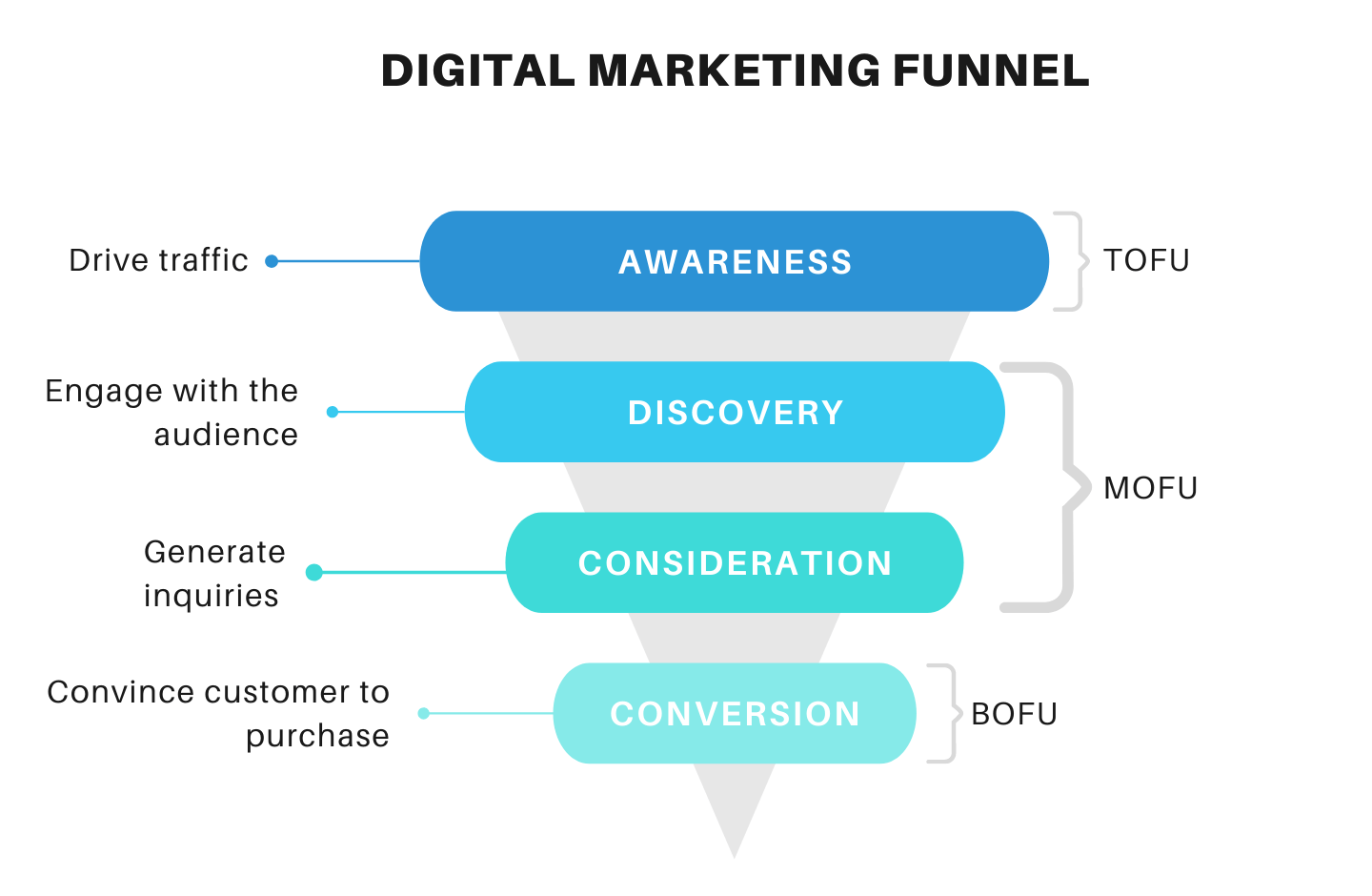
B2C marketers can get away with focusing solely on commercial terms (e.g., “buy protein powder,” for example), but B2B marketers must also target informational queries (e.g., “how to use project management software.”).
Remember, B2B SEO will focus more on these long-tail, lower-volume keywords. The information buyers gather from these searches is essential to their decision-making process.
Companies that provide value at this funnel stage are likelier to win the buyer as a customer.
The best way to target long-tail keywords while providing value is through content marketing.
Here are some of the ways to use content marketing for B2B SEO:
Create in-depth guides
In-depth guides are one of the best types of B2B content for SEO. Decision-makers frequently search for information that helps them do their job. Creating thorough content that answers all their questions is a great way to get your company on their radar.
Furthermore, B2B buyers need confidence that the companies they buy from are trusted experts in their field.
When it comes time to finalize the purchase decision, your company will get more consideration.
Blog about B2B related topics
Regularly posting industry-related topics on your blog is another way to establish your business as an authority.
If your blog is a consistent, valuable source of information, prospects will regularly visit your site to stay informed about the latest developments.
Additionally, many readers will share your content with their peers, increasing your exposure and position as a thought leader in your industry.
2. Build your LinkedIn Network
LinkedIn is the most impactful social media platform for B2B companies.
Designed specifically for businesses and the people who work for them, the platform is great for helping professionals connect with their peers to grow their business network.
Building a network is important, as the connections can lead to more business for your company. This could be people from your network becoming customers or referrals of other companies that would make good prospects.
According to LinkedIn, 80% of all B2B marketing leads come through the platform.
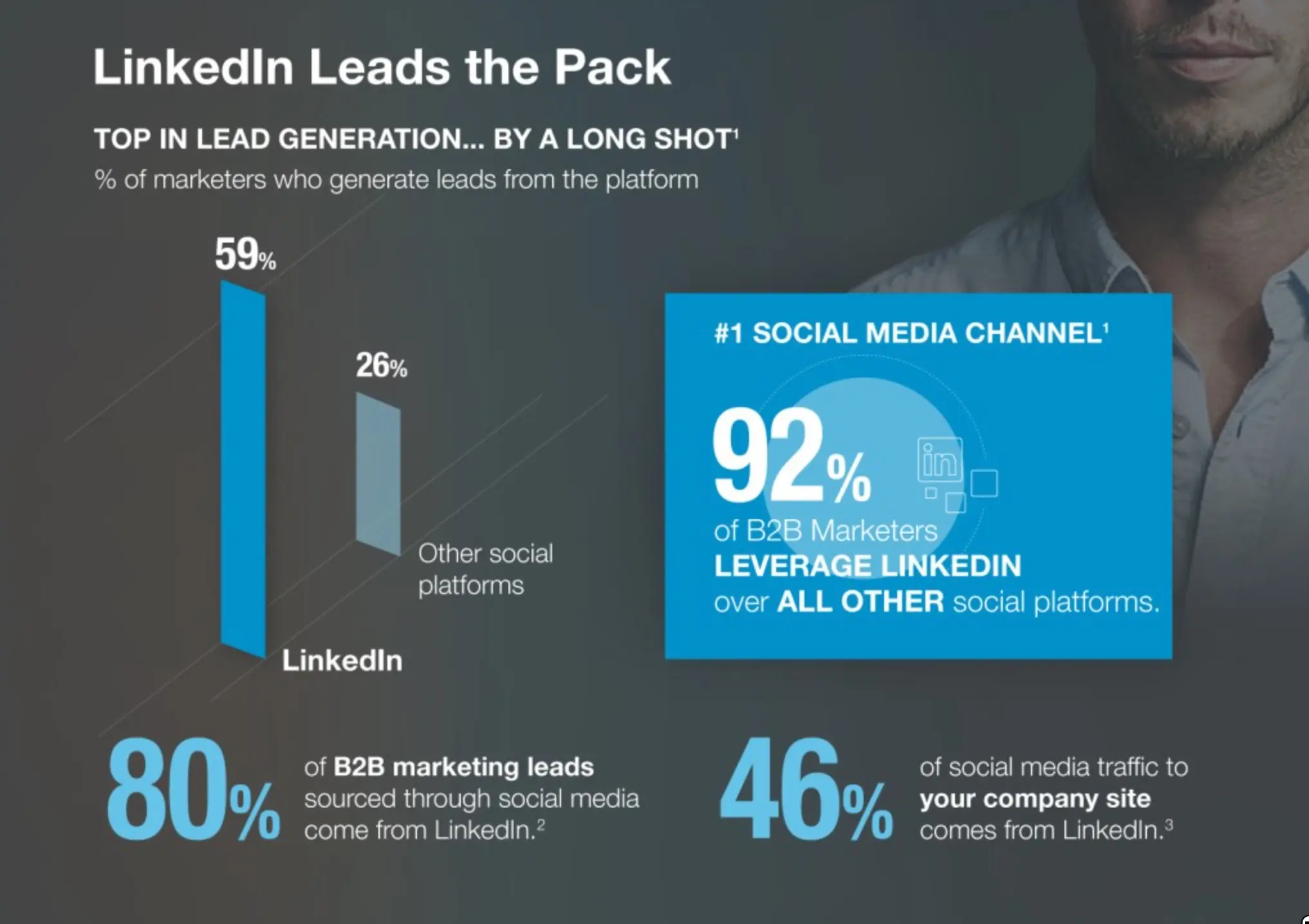
LinkedIn has many users, and these users are the influential decision-makers that B2B marketers need to communicate with. Internal LinkedIn Research shows that there are 63 million decision-makers on the platform.
Beyond networking, LinkedIn also has a strong organic reach. By posting content on LinkedIn, you can strengthen the connection with your network while making potential buyers aware of your solution.
Many B2B marketers will regularly write business-related articles specifically for LinkedIn and their network on the platform.
Another great way to connect with your audience is through virtual events. With the LinkedIn Events feature, you can host online workshops and seminars. You can then send invitations to the people that you want to attend.
If the event goes well, it can increase connections for your LinkedIn profile.
3. Try LinkedIn Paid Ads
Sharing content and networking with professionals isn’t the only way to use LinkedIn to market to B2B buyers.
The network also has a robust advertising platform for generating leads and driving sales.
LinkedIn Ads offer unparalleled targeting for B2B marketers. You can target people based on education, member groups, job experience, skills, and more.
Because LinkedIn is the go-to professional networking platform, many users keep their profiles updated, which makes the information used for ad targeting highly accurate.
This makes it great for getting your business in front of the people who are most likely to buy from your company.
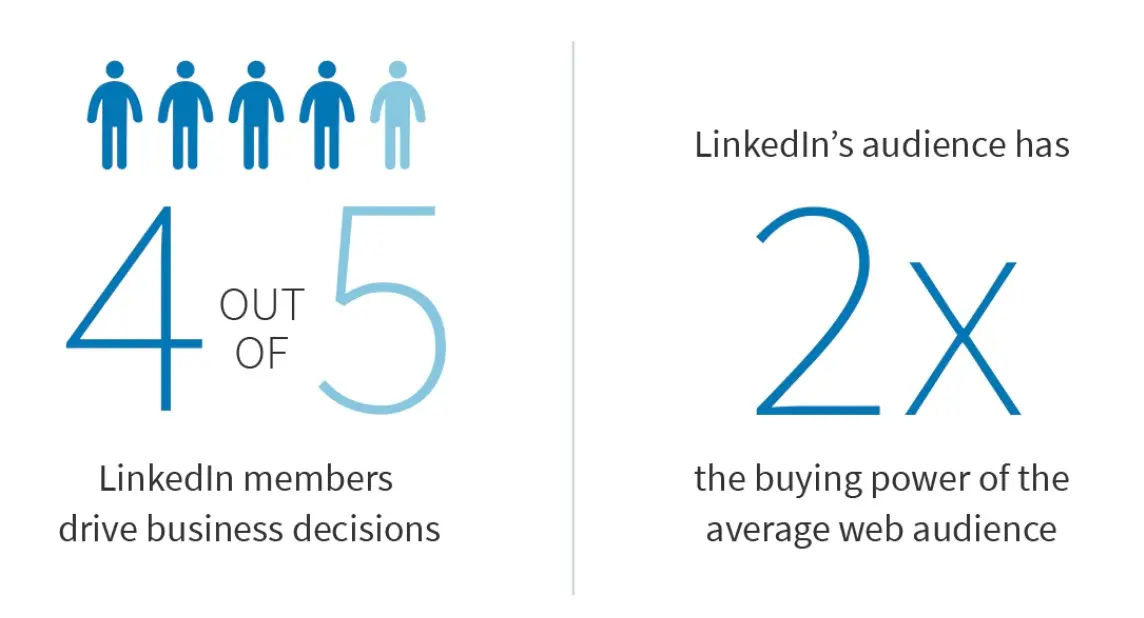
Setting up LinkedIn Ads
There are several LinkedIn ad formats that are effective for generating B2B leads.
Text ads are simple ads that appear on LinkedIn in the right-hand sidebar. These ads contain a logo and a brief snippet of text.
Then there are a variety of ad formats for sponsored content including video ads, single image ads, and carousel ads. These ads appear in users’ news feeds among the organic content from their connections and groups.
With LinkedIn, you can also reach people directly using Sponsored InMail ads that appear in people’s LinkedIn messaging inboxes.
A B2B advertising strategy often includes all of these ad campaigns as each is more appropriate for different points of a customer’s relationship.
For instance, a Sponsored InMail message is better suited for someone who has already had a few interactions with your business.
To get the best results from your ads, you want to use clear compelling language that is relevant to your target audience. You can make use of your existing resources by promoting your blog posts and other lead generation content.
4. Use Twitter to Build Relationships
Like LinkedIn, Twitter is a great platform for connecting with other business professionals. The platform makes it easy to find people of similar interests and you can quickly form a community of engaged followers.
You want to follow and interact with relevant figures in your industry. You can like and retweet their tweets and leave comments to share your insights and keep the conversation going.
It’s also good to look at who these people are following and follow them to expand your community further.
B2B Twitter content
Twitter’s character limit makes it better suited for quick interactive content and sharing links to external sites rather than posting long-form text.
It’s also important to post frequently with the platform, as B2B audiences are more likely to engage with someone they know.
According to Twitter Data, a B2B user who has seen a business message four times is 335% more likely to click the link in a Tweet than someone who has only seen your message once.
So while you must post often, remember that strictly promotional posts won’t help your presence on the platform. Look to provide value with each interaction by giving valuable insights or sharing your other information content.
Another tactic is to create original research. According to eMarketer, B2B content marketers believe that original research is their most effective form of content.
This type of material works well with Twitter’s short-form nature, as you can easily fit several impactful statistics into a Tweet.
5. Run Brand Awareness Campaigns
The first step in any business becoming a customer is simply becoming aware of your brand. According to The B2B Institute, 46% of a company’s marketing spend should go to brand building.
Generating brand awareness is more than just getting your logo and business name in front of your audience. You need to convey a clear image of what your company offers and how you can benefit customers.
B2B brand awareness efforts should have a mix of both organic and paid campaigns.
Naturally, LinkedIn is a great platform for B2B brand awareness as users are in a business mindset while on the platform. This means they are more likely to engage with your business content and ads and return to your website to learn more about your business.
Advertising through Google, Facebook, and YouTube is also an effective way to grow awareness of your brand. With these platforms, you can easily target relevant people in your audience that have yet to interact with your business.
Enrolling in a digital marketing course is the best way to learn how to raise brand awareness for your business.
6. Get Leads With Retargeting Campaigns
It will take multiple interactions in most cases before a prospect becomes a lead. B2B decision-makers aren’t likely to immediately complete a contact form for a solution they’ve just heard about.
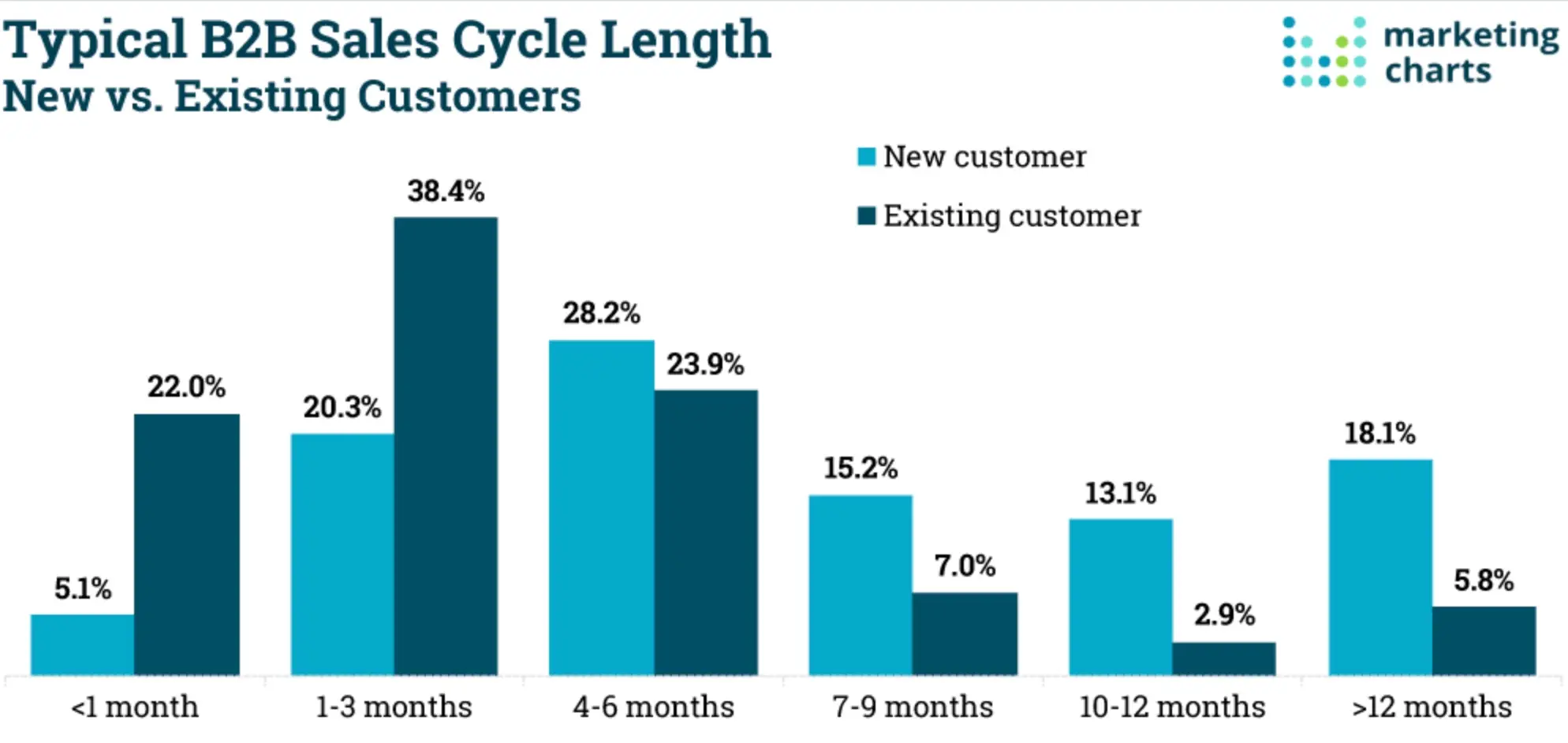
In fact, nearly 75% of B2B sales to new customers take at least 4 months to close, and it takes 6 to 8 touchpoints to turn someone into a lead.
This means you need a proactive way to get back in front of people to remind them about your business.
Retargeting ads allow you to set up a campaign that specifically targets the people who have previously visited your site.
These campaigns can experience higher conversion rates as the audience is already familiar with your business. This can lead to more cost-effective marketing as you can get more value out of your ad spend.
Retargeting campaigns also let you get hyper-specific with your messaging as you have more insights into the audience’s interest. For example, if someone visits a particular product page multiple times, you can use a retargeting ad to promote that exact product.
Platforms for retargeting ads
Because LinkedIn is the best place to reach B2B buyers and is the best platform for running retargeting ads.
With LinkedIn, you can create Matched Audiences consisting of people who have visited your site or engaged with one of your LinkedIn Ads.
Google is another good platform for B2B retargeting ads. With Google remarketing, you can show display and video ads to people who have previously interacted with your site.
7. Send an Industry Updates Newsletter
An email newsletter is great for nurturing relationships both before and after someone becomes a customer.
Email gives you a direct line to potential buyers, and email messages often get better responses and engagement than ads.
This is because someone must first sign up to join your email newsletter, so there’s already some interest.
Like the content on your site, your email newsletter should focus on providing useful information to your audience rather than trying to simply sell.
According to OptinMonster, 90% of top-performing B2B content marketers put the audience’s informational needs first.
So, look to establish authority while developing strong relationships with both current and prospective clients.
But keep in mind, B2B buyers are busy people and many won’t have the time to read long email messages. It’s best to send short emails that can be read efficiently.
Here are some common ways B2B marketers use email newsletters to engage their audience:
News and updates
Your email newsletter can be used to keep your subscribers up to date with industry events and changes.
You can also send product and feature updates related to your business.
For example, project management software ClickUp sends weekly ClickUpdates emails with new feature releases and links to upcoming webinars.
Repurpose and share content
Repurposed content such as blogs, podcasts, webinars, and social posts are great for email messages. You can use these to share the same tips and guidance but in a condensed form.
This will help you save time and get your most valuable resources in front of more of your audience.
For example, you can send roundups of recent posts or summaries of case studies and customer stories.
8. Launch a YouTube Channel
While blog posts and email newsletters are long-standing B2B marketing strategies, many B2B marketers now use video platforms like YouTube to connect with their audience and drive interest in their products.
The platform is the second-biggest search engine behind Google, and many decision-makers use it to find in-depth video content related to their business’ key pain points.
YouTube videos are an effective tool for teaching your audience about your products. You can start a YouTube channel and create how-to tutorials and explainer videos that go through your products, their features, and how to use them.
This material is great for supplementing your blog material. You can create videos related to your posts and embed them on the blog to accompany the content.
Optimize your videos for YouTube SEO
If your videos aren’t optimized for SEO, they won’t reach your target audience.
Like SEO for Google, performing keyword research is the first step to improving your video rankings. When you know what keywords viewers use, you can tailor your videos to target those terms best.
You’ll do this by directly addressing the search term and topic in the content itself. It will also involve you adding the keywords to the video description, title, tags, and hashtags.
Read our comprehensive tutorial to learn more about YouTube SEO and how to utilize it in your B2B marketing strategy.
9. Run Google Search Ads
Remember, B2B research for products and services starts on Google.
An effective SEO strategy will help you get in front of searchers, but you can also use Google Search Ads to reach more of your audience.
With a Google Search Ad, your website will appear at the top of search results for the specific keywords you target in your campaign settings.
Google Search campaigns are beneficial for attracting customers that would have otherwise missed your site in the organic results. Plus, they work well for all stages of the B2B buyers funnel.
For the awareness stage, you can target terms at the beginning of the research process, like “what is a product name” or “ top businesses in X industry.”
These ads can make prospective buyers aware of your brand. You can direct them to a corresponding blog post that answers the question.
During the evaluation stage, you can focus on high-intent search terms where the searcher clearly intends to make a purchase. For example, queries such as “how much do products cost?”
Another common type of targeting for B2B companies is keywords that contain a competitor's brand name.
Enrolling in a Google Ads course is a great way to learn how to use Google Ads for B2B marketing purposes.
10. Partner With Other Businesses
B2B business partnerships can yield huge benefits for all parties involved. While they can take some time to put together, working with other companies can allow you to create a network to reach new prospects and grow brand awareness.
B2B marketing partnerships sometimes occur naturally, but in most cases, they are the result of direct action on the part of one or both partners.
When approaching other businesses for partnerships, you’ll need to know what you want to achieve and how to structure the collaboration.
Some common arrangements include co-marketing agreements, where you share experiences to create content, lead-sharing agreements, or offering a bundled product. Many partnerships also offer customers special offers to get the other businesses’ products at discounted rates.
Here are some of the ways you can partner with other B2B marketers:
Run events
Events are one of the most effective marketing strategies for B2B partnerships. With a co-host, you can scale your event’s attendance to cover a larger audience base.
You also get to split the cost and have twice as many experts to share valuable insights with attendees.
Webinars and lead generation content
B2B partnerships are also beneficial for creating lead-generation content like webinars. Companies can collaborate to share expertise and create more well-rounded content that better serves both audiences.
Start an affiliate program
Affiliate marketing allows companies to leverage the efforts of third parties to market their products.
With an affiliate program, you can partner with other companies and have them refer your customers in exchange for part of the revenue as a commission.
Conclusion
While it may seem complex, B2B marketing can yield positive results by following a few simple steps.
Create helpful content for your website, emails, and social channels, grow your network on LinkedIn and Twitter, and reach and re-engage your audience through paid ads.
These steps will go a long way in making your audience aware of your business and eventually winning them over as customers.
